The Intel Core i9-9900KS Review: The 5 GHz Consumer Special
by Dr. Ian Cutress on October 31, 2019 10:45 AM ESTCPU Performance: System Tests
Our System Test section focuses significantly on real-world testing, user experience, with a slight nod to throughput. In this section we cover application loading time, image processing, simple scientific physics, emulation, neural simulation, optimized compute, and 3D model development, with a combination of readily available and custom software. For some of these tests, the bigger suites such as PCMark do cover them (we publish those values in our office section), although multiple perspectives is always beneficial. In all our tests we will explain in-depth what is being tested, and how we are testing.
All of our benchmark results can also be found in our benchmark engine, Bench.
Application Load: GIMP 2.10.4
One of the most important aspects about user experience and workflow is how fast does a system respond. A good test of this is to see how long it takes for an application to load. Most applications these days, when on an SSD, load fairly instantly, however some office tools require asset pre-loading before being available. Most operating systems employ caching as well, so when certain software is loaded repeatedly (web browser, office tools), then can be initialized much quicker.
In our last suite, we tested how long it took to load a large PDF in Adobe Acrobat. Unfortunately this test was a nightmare to program for, and didn’t transfer over to Win10 RS3 easily. In the meantime we discovered an application that can automate this test, and we put it up against GIMP, a popular free open-source online photo editing tool, and the major alternative to Adobe Photoshop. We set it to load a large 50MB design template, and perform the load 10 times with 10 seconds in-between each. Due to caching, the first 3-5 results are often slower than the rest, and time to cache can be inconsistent, we take the average of the last five results to show CPU processing on cached loading.

The 9900KS hits the top of all the consumer processors in our app loading test.
FCAT: Image Processing
The FCAT software was developed to help detect microstuttering, dropped frames, and run frames in graphics benchmarks when two accelerators were paired together to render a scene. Due to game engines and graphics drivers, not all GPU combinations performed ideally, which led to this software fixing colors to each rendered frame and dynamic raw recording of the data using a video capture device.
The FCAT software takes that recorded video, which in our case is 90 seconds of a 1440p run of Rise of the Tomb Raider, and processes that color data into frame time data so the system can plot an ‘observed’ frame rate, and correlate that to the power consumption of the accelerators. This test, by virtue of how quickly it was put together, is single threaded. We run the process and report the time to completion.
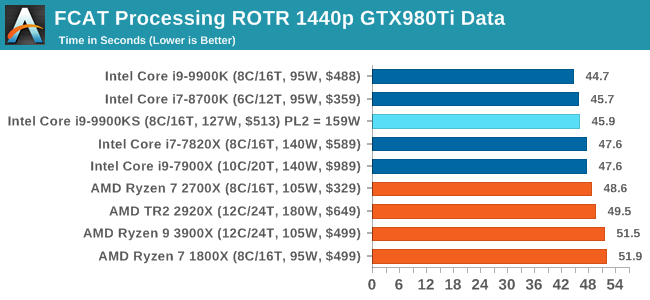
For some reason our default 9900KS run didn't seem to perform properly, but the 9900KS at Intel guidelines did, within the margin of error of the 9900K which also does turbo at 5.0 GHz.
3D Particle Movement v2.1: Brownian Motion
Our 3DPM test is a custom built benchmark designed to simulate six different particle movement algorithms of points in a 3D space. The algorithms were developed as part of my PhD., and while ultimately perform best on a GPU, provide a good idea on how instruction streams are interpreted by different microarchitectures.
A key part of the algorithms is the random number generation – we use relatively fast generation which ends up implementing dependency chains in the code. The upgrade over the naïve first version of this code solved for false sharing in the caches, a major bottleneck. We are also looking at AVX2 and AVX512 versions of this benchmark for future reviews.
For this test, we run a stock particle set over the six algorithms for 20 seconds apiece, with 10 second pauses, and report the total rate of particle movement, in millions of operations (movements) per second. We have a non-AVX version and an AVX version, with the latter implementing AVX512 and AVX2 where possible.
3DPM v2.1 can be downloaded from our server: 3DPMv2.1.rar (13.0 MB)
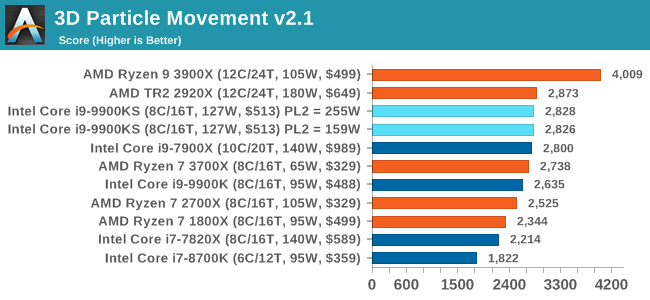
Without AVX acceleration, the Core i9-9900KS hardware manages to push ahead of the 9900K due to the extra frequency, and even above the 10-core 7900X. Because these are non-AVX instructions, they aren't pushing the CPU as hard as it can be, so we're not really draining the turbo bucket in our 159W PL2 test.
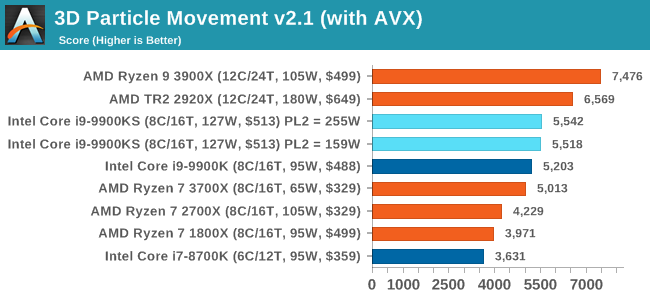
On the other hand, our AVX2 accelerated test is also showing both PL2 settings performing about equal. This test does involve a 10-second delay between each of its six subtests, which allows some turbo budget to be regained. Couple that with the 30 second delay between individual runs, it would appear that there's enough turbo budget for the whole run.
Dolphin 5.0: Console Emulation
One of the popular requested tests in our suite is to do with console emulation. Being able to pick up a game from an older system and run it as expected depends on the overhead of the emulator: it takes a significantly more powerful x86 system to be able to accurately emulate an older non-x86 console, especially if code for that console was made to abuse certain physical bugs in the hardware.
For our test, we use the popular Dolphin emulation software, and run a compute project through it to determine how close to a standard console system our processors can emulate. In this test, a Nintendo Wii would take around 1050 seconds.
The latest version of Dolphin can be downloaded from https://dolphin-emu.org/
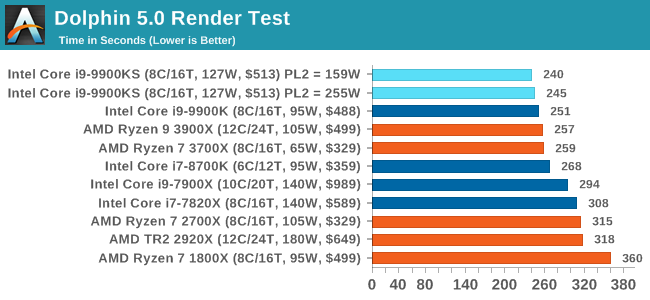
Dolphin loves single threaded performance, so we see the 9900 series at the top here.
DigiCortex 1.20: Sea Slug Brain Simulation
This benchmark was originally designed for simulation and visualization of neuron and synapse activity, as is commonly found in the brain. The software comes with a variety of benchmark modes, and we take the small benchmark which runs a 32k neuron / 1.8B synapse simulation, equivalent to a Sea Slug.
Example of a 2.1B neuron simulation
We report the results as the ability to simulate the data as a fraction of real-time, so anything above a ‘one’ is suitable for real-time work. Out of the two modes, a ‘non-firing’ mode which is DRAM heavy and a ‘firing’ mode which has CPU work, we choose the latter. Despite this, the benchmark is still affected by DRAM speed a fair amount.
DigiCortex can be downloaded from http://www.digicortex.net/
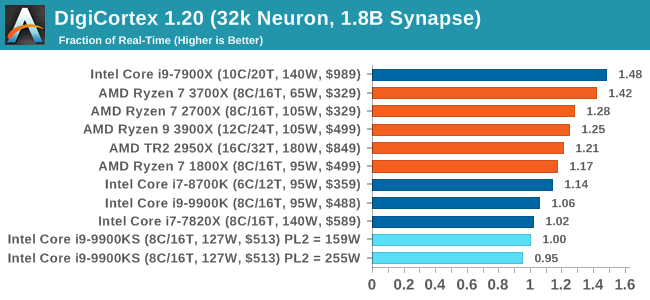
Interestingly enough the big splot in this benchmark series is here with DigiCortex. I'm not sure what's going on here; not only with the result being low (due to DDR4-2666 compared to AMD's higher support) but also lower than the 9900K.
y-Cruncher v0.7.6: Microarchitecture Optimized Compute
I’ve known about y-Cruncher for a while, as a tool to help compute various mathematical constants, but it wasn’t until I began talking with its developer, Alex Yee, a researcher from NWU and now software optimization developer, that I realized that he has optimized the software like crazy to get the best performance. Naturally, any simulation that can take 20+ days can benefit from a 1% performance increase! Alex started y-cruncher as a high-school project, but it is now at a state where Alex is keeping it up to date to take advantage of the latest instruction sets before they are even made available in hardware.
For our test we run y-cruncher v0.7.6 through all the different optimized variants of the binary, single threaded and multi-threaded, including the AVX-512 optimized binaries. The test is to calculate 250m digits of Pi, and we use the single threaded and multi-threaded versions of this test.
Users can download y-cruncher from Alex’s website: http://www.numberworld.org/y-cruncher/
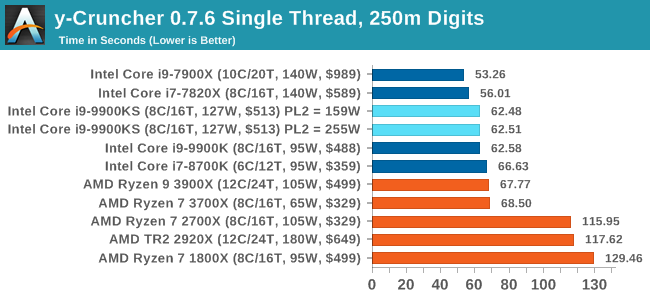
y-Cruncher can use AVX512 for the HEDT chips, as they are faster than the 9900KS, but all the 9900 series are performing similarly at 5.0 GHz single threaded here.
Agisoft Photoscan 1.3.3: 2D Image to 3D Model Conversion
One of the ISVs that we have worked with for a number of years is Agisoft, who develop software called PhotoScan that transforms a number of 2D images into a 3D model. This is an important tool in model development and archiving, and relies on a number of single threaded and multi-threaded algorithms to go from one side of the computation to the other.
In our test, we take v1.3.3 of the software with a good sized data set of 84 x 18 megapixel photos and push it through a reasonably fast variant of the algorithms, but is still more stringent than our 2017 test. We report the total time to complete the process.
Agisoft’s Photoscan website can be found here: http://www.agisoft.com/
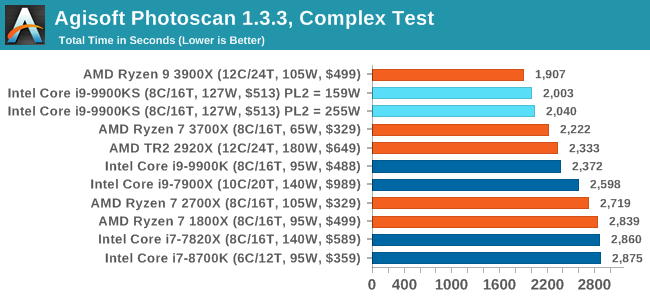
Agisoft is a more variable workload, so there will be bits here and there where both processors can fully go to 5.0 GHz turbo and recover budget. The 12-core AMD chip is ahead, and both 9900KS settings are almost equal. They are both ahead of the normal 9900K by just over 10%.













235 Comments
View All Comments
Galid - Friday, November 1, 2019 - link
A little mistake on my part, it was my AMD Athlon 64 3200+ and not the x2. The worst about this problem was that the chipset (nForce3-250 or something like that) was made by Nvidia and it had problems with their video cards only.I forgot to mention that we bought a new system for my brother because the CPU died, I think that's the only cpu that ever died on me and it was an i5-2500k. The most shocking about that is I overclocked mine to 4.7ghz for all these years and it's still going strong(hence the reason I'm still waiting to upgrade). He bought some closed loop water cooling and never overclocked the cpu still it died on him... shame.
alufan - Wednesday, November 6, 2019 - link
hmm so intel has better quality etc lets consider for a moment all the security issues with intel, then lets look at the way they refused to develop the cpu until AMD came alont with 12, then 12+ then 7 and shortly 7+ meanwhile intel cannot make a decent 10nm chip speaks volumes about your argument, then lets look at the TDP the AMD chip at 65w is almost neck and neck with the intel one at 255w !Only cpu i ever had fail was a core 2 duo never lost a GPU from either camp but guess what... the intel GPU is being design led by a former AMD/ATI staffer as is the new intel CPU as well, think we can leave it there
outsideloop - Friday, November 1, 2019 - link
If you want stream your game while paying, get the 3900X.outsideloop - Friday, November 1, 2019 - link
While playing...flyingpants265 - Monday, November 4, 2019 - link
No more of the weird streaming comments please. Nobody really streams.BikeDude - Wednesday, November 6, 2019 - link
<blockquote>more mature product</blockquote>But all reports so far indicates that Intel has been hit much harder by spectre-class bugs?
"All the issues that came out this year, were reported not to be an issue on AMD" (https://www.theregister.co.uk/2019/10/29/intel_dis...
Midwayman - Thursday, October 31, 2019 - link
Curious you think that someone considering a 9900KS is a 'budget' gamer. You could easily make that argument with any high end component. I'd expect them to be pairing this with both a 2080ti and a high refresh monitor.evernessince - Friday, November 1, 2019 - link
I think you are mistaking enthusiast for "fool". I've bought a 980 Ti and a 1080 Ti but I sure as hell ain't going to buy a 2080 Ti. I had a 5820K and bought a 3700X.Thankfully, there are some of us with some fiscal responsibility.
Spunjji - Friday, November 1, 2019 - link
Cheers for doing your bit to reign in the madness.Death666Angel - Saturday, November 2, 2019 - link
And to add to that, I can easily fit a high end 200W+ TDP CPU cooler in my small mATX case, but I cannot fit a graphics card that is longer than 26 cm (23.5 cm after my front fan modifications) into my case. SFF systems are more limited by graphics card size than cooler size most of the time. And the best cards in a smaller form factor are 1080 TI and 2070 Super as far as I know.